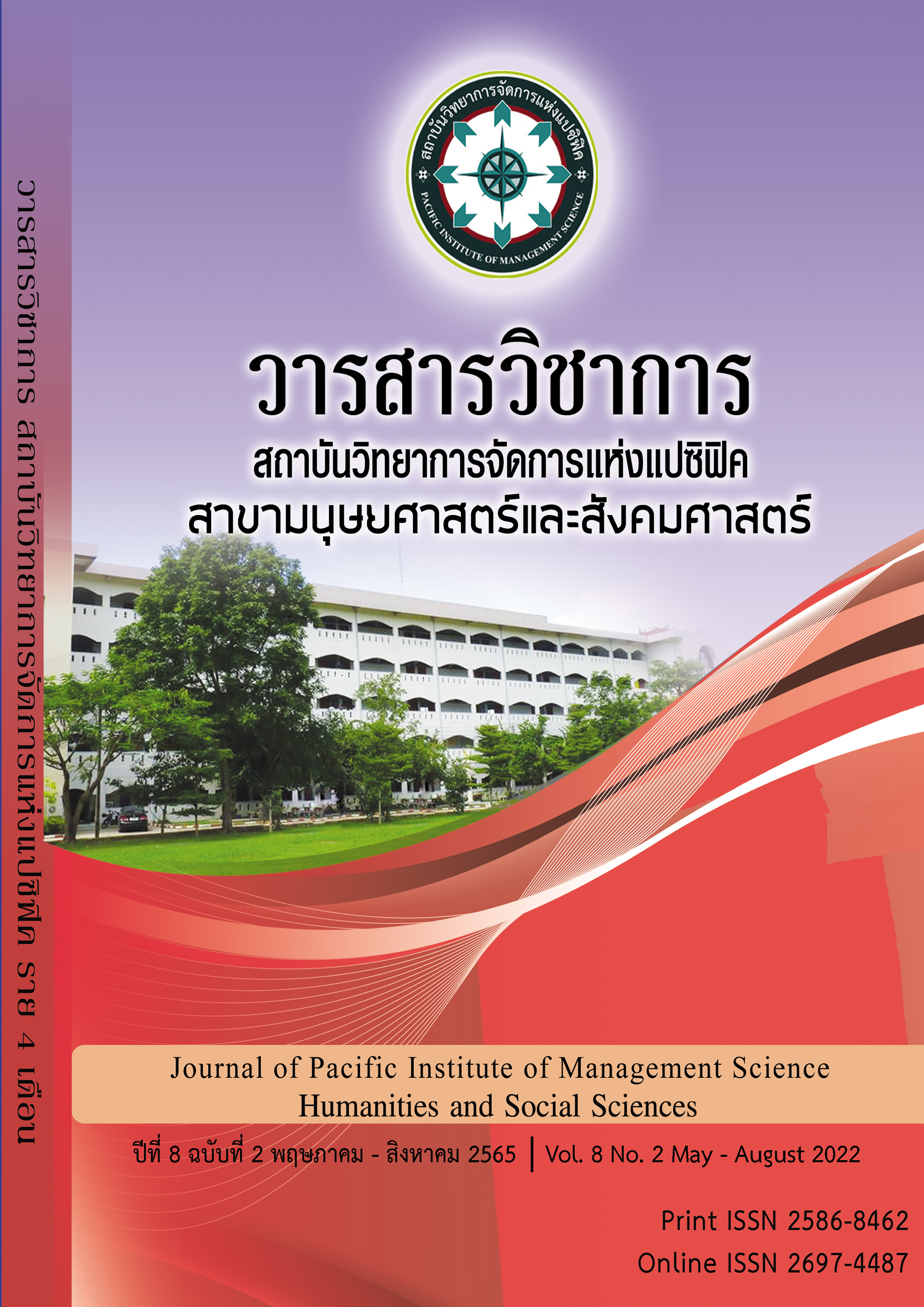Development of Watercolor Skills in an Artistic Imagination Course Using the Instructional Method Based on Simpson’s Practical Skills Development Model
Keywords:
Watercolor skills, Teaching and learning process, Simpson’s Practical Skill Development ModelAbstract
The purposes of this research are as follows: (1) to develop an instructional method for watercolors, based on Simpson’s practical skill development model and (2) to develop the watercolor skills of students in the Artistic Imagination course, using the developed instructional method based on Simpson’s practical skill development model. The samples in this research were eight students in Matthayom Suksa Six studying English-Home Economics in English in the 2020 academic year at Saipanya School. The samples were selected by purposive sampling. The research tools comprised as follows: (1) The instructional method for watercolors based on Simpson’s practical skill development model (2) The interview forms for watercolor experts and (3) the evaluation form for the watercolor skills of students. The findings are as follows: (1) the seven-step instructional method of watercolor based on Simpson’s practical skill development model was established by experts to be at 0.91 IOC (Index of Item-Objective Congruence) Hence, it can be used to teach watercolor painting. The teaching and learning process allowed students to practice their skills step-by-step. With more practice, the students could use watercolors more effectively. As a result, the students can benefit from their work and enjoy studying Artistic Imagination; (2) the learning achievement of the students was at a 0.05 level of statistical significance. The score of practical skills in the watercolors of the students who have learned through the seven-step instructional method for watercolors and based on Simpson’s practical skills development model was high, respectively.
References
กระทรวงศึกษาธิการ. (2552). หลักสูตรแกนกลางการศึกษาขั้นพื้นฐาน พุทธศักราช 2551. กรุงเทพฯ: โรงพิมพ์ชุมนุมสหกรณ์การเกษตรแห่งประเทศไทย จำกัด.
โกศล พิณกุล. (2545). รูปแบบและเทคนิคการระบายสีน้ำ. กรุงเทพฯ: สิปประภา
จันทร์เพ็ญ ภัทรมานนท์. (2553). ผลการจัดกิจกรรมการเรียนรู้ สาระนาฏศิลป์ เรื่อง รำวงมาตรฐาน ชั้นมัธยมศึกษาปีที่ 1 โรงเรียนสามพาดพิทยาคาร ตามแนวคิดของซิมพ์ซัน. การศึกษาค้นคว้าอิสระ กศ.ม. (หลักสูตรและการสอน). มหาวิทยาลัยมหาสารคาม, มหาสารคาม.
ชาติชาย สร้อยดอกสน. (2561). ผลการใช้บทเรียน เรื่องศิลปะการป้องกันตัวแบบไอคิโด โดยใช้แนวคิดการพัฒนาทักษะปฏิบัติของซิมพ์ซัน สำหรับนักเรียนชั้นประถมศึกษาปีที่ 6. วิทยานิพนธ์ กศ.ม. (หลักสูตรและการสอน). มหาวิทยาลัยบูรพา, ชลบุรี.
ฉวีวรรณ กุดหอม. (2557). การพัฒนากิจกรรมการเรียนรู้วิชานาฏศิลป์ตามรูปแบบซิปปาและรูปแบบการพัฒนาทักษะปฏิบัติของซิมพ์ซัน ระดับชั้นมัธยมศึกษาปีที่ 2. ปริญญานิพนธ์ ค.ม. (หลักสูตรและการสอน) . สกลนคร: บัณฑิตวิทยาลัย มหาวิทยาลัยราชัฏสกลนคร
ทิศนา แขมมณี. (2554). ศาสตร์การสอน : องค์ความรู้เพื่อการจัดการกระบวนการเรียนรู้ที่มีประสิทธิภาพ. พิมพ์ครั้งที่ 9. กรุงเทพฯ: สำนักพิมพ์แห่งจุฬาลงกรณ์มหาวิทยาลัย
ธัชชา เทศน์ธรรม. (2559). การเปรียบเทียบผลสัมฤทธิ์การเรียนรู้เรื่องการระบายสีน้ำ ด้วยรูปแบบการสอนแบบโครงงาน. ปริญญานิพนธ์ กศ.ม. (ศิลปศึกษา). กรุงเทพฯ: บันฑิตวิทยาลัย มหาวิทยาลัยศรีนครินทรวิโรฒ.
นิติพงศ์ ใจประสาท. (2540). การเขียนสีน้ำ. กรุงเทพฯ: อีแอนด์ไอคิว.
นัฐประชา หงษ์สุวรรณ. (2561). สีน้ำภาคปฏิบัติ (ฉบับปรับปรุง). กรุงเทพฯ: วาดศิลป์.
นภดล เนตรดี. (2554). การเขียนภาพสีน้ำ. กรุงเทพฯ: วาดศิลป์.
บุสรินทร์ พาระแพน (2561). การพัฒนาชุดการเรียนรู้การแสดงนาฏศิลป์พื้นบ้านตามแนวคิดทักษะปฏิบัติของซิมพ์ซัน ที่ส่งเสริมบุคลิกภาพและความคิดสร้างสรรค์การปฏิบัติท่ารำ นักเรียนชั้นมัธยมศึกษาปีที่ 3. วิทยานิพนธ์ กศ.ม. (หลักสูตรและการสอน). มหาวิทยาลัยมหาสารคาม, มหาสารคาม.
ปภิชญา เรืองโค. (2561). การพัฒนาบทเรียนเว็บโดยใช้รูปแบบการเรียนการสอนตามแนวคิดการพัฒนาทักษะปฏิบัติของซิมพ์ซันเพื่อส่งเสริมทักษะปฏิบัติและความคิดสร้างสรรค์สำหรับนักเรียนชั้นมัธยมศึกษาปีที่ 3. วิทยานิพนธ์ ค.ม. (คอมพิวเตอร์ศึกษา). มหาวิทยาลัยราชภัฎมหาสารคาม, มหาสารคาม
ไพฑูรย์ สินลารัตน์. (2545). ผ่าทางตันปฏิรูปการศึกษา. กรุงเทพฯ: อมรินทร์พริ้นติ้งแอนด์พับลิชชิ่ง จำกัด.
เฟยเล่อเหนี่ยว. (2559). หนังสือหัดวาดสีน้ำเล่มแรกของฉัน. แปลโดย ณิชา. กรุงเทพฯ: ไอดีซี พรีเมียร์ จำกัด.
เยาวภา เดชะคุปต์. (2522). ทฤษฎีกระบวนการกลุ่มสัมพันธ์สำหรับการสอนในระดับประถมศึกษา. วิทยานิพนธ์ ค.ม. (ประถมศึกษา). กรุงเทพฯ: จุฬาลงกรณ์.
วิรุณ ตั้งเจริญ. (2526). ศิลปศึกษา. กรุงเทพฯ: พายัพออฟเซ็ทพรินท์การพิมพ์.
วรรณรัตน์ ตั้งเจริญ. (2546). สีน้ำสร้างสรรค์. กรุงเทพฯ: สันติศิริการพิมพ์.
สภาพัฒนาการเศรษฐกิจและสังคมแห่งชาติ. (๒๕๔๙). แผนพัฒนาเศรษฐกิจและสังคมแห่งชาติฉบับที่ ๑๐.
สำนักนายกรัฐมนตรี (2542). พระราชบัญญัติการศึกษาแห่งชาติ พ.ศ. 2542. กรุงเทพฯ: โรงพิมพ์องค์การรับส่งสินค้าและพัสดุภัณฑ์ (ร.ส.พ.).
อนันต์ ประภาโส. (2551). วาดสีน้ำง่ายๆสไตล์ครูอุ๋ย : ทิวทัศน์. กรุงเทพฯ: สิปประภา.
อภิญญา สิทธิวงศ์. (2558). การศึกษาพัฒนาโครงงานเปรียบเทียบความคิดสร้างสรรค์ในการเรียนวิชาศิลปะ เทคนิคจิตรกรรมสีน้ำ ของนักเรียนชั้นมัธยมศึกษาปีที่ 3 โรงเรียนไทยคริสเตียน กรุงเทพมหานคร ที่เรียนด้วยการจัดการเรียนรู้แบบโครงงาน. ปริญญานิพนธ์ กศ.ม. (ศิลปศึกษา). กรุงเทพฯ: บันฑิตวิทยาลัย มหาวิทยาลัยศรีนครินทรวิโรฒ. ถ่ายเอกสาร.
อารี สุทธิพันธุ์. (2526). การระบายสีน้ำ. กรุงเทพฯ: สำนักพิมพ์กระดาษสา
Clark, Ann-Marie. (2001, December). Implementing the project Approach : A Beginner’ s Perspective. Dissertation Abstracts International. 62(6),99. 2014-A.
Muhammad, M (2018). Development of Watercolor Painting Technique Module on Extracurricular Activities in Secondary Schools. 7
Owen, Pamela Mae. (2002, August). Bridging Theory and Practice : Student Teachers use the Project Approach. Dissertation Abstracts International, 63(2), pp. 563-A.
Sotiropoulou, M (2012). If the pedagogic community can understand new ways of combining teaching practices with aesthetic learning activities. Art Education, 65(1), 7-10.
Downloads
Published
Issue
Section
License
Copyright (c) 2022 Pacific Institute of Management Science

This work is licensed under a Creative Commons Attribution-NonCommercial-NoDerivatives 4.0 International License.
บทความที่ได้รับการตีพิมพ์เป็นลิขสิทธิ์ของ สถาบันวิทยาการจัดการแห่งแปซิฟิค
ข้อความที่ปรากฏในบทความแต่ละเรื่องในวารสารวิชาการเล่มนี้เป็นความคิดเห็นส่วนตัวของผู้เขียนแต่ละท่านไม่เกี่ยวข้องกับสถาบันวิทยาการจัดการแห่งแปซิฟิค และคณาจารย์ท่านอื่นๆในสถาบันฯ แต่อย่างใด ความรับผิดชอบองค์ประกอบทั้งหมดของบทความแต่ละเรื่องเป็นของผู้เขียนแต่ละท่าน หากมีความผิดพลาดใดๆ ผู้เขียนแต่ละท่านจะรับผิดชอบบทความของตนเองแต่ผู้เดียว







